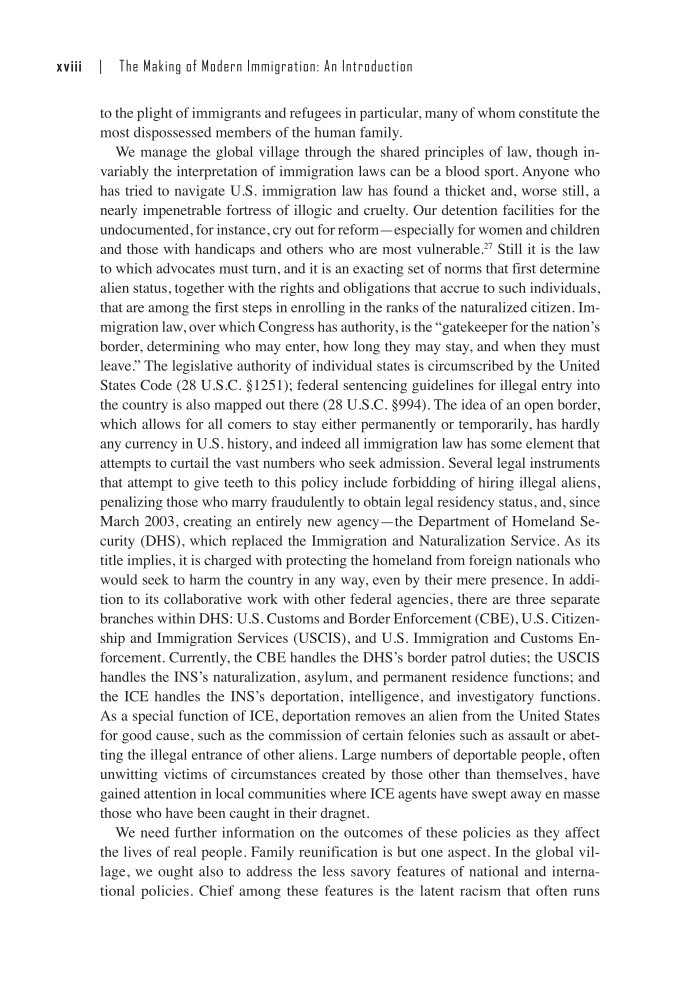| The Making of Modern Immigration: An Introduction xviii to the plight of immigrants and refugees in particular, many of whom constitute the most dispossessed members of the human family. We manage the global village through the shared principles of law, though in- variably the interpretation of immigration laws can be a blood sport. Anyone who has tried to navigate U.S. immigration law has found a thicket and, worse still, a nearly impenetrable fortress of illogic and cruelty. Our detention facilities for the undocumented, for instance, cry out for reform—especially for women and children and those with handicaps and others who are most vulnerable. 27 Still it is the law to which advocates must turn, and it is an exacting set of norms that first determine alien status, together with the rights and obligations that accrue to such individuals, that are among the first steps in enrolling in the ranks of the naturalized citizen. Im- migration law, over which Congress has authority, is the “gatekeeper for the nation’s border, determining who may enter, how long they may stay, and when they must leave.” The legislative authority of individual states is circumscribed by the United States Code (28 U.S.C. §1251) federal sentencing guidelines for illegal entry into the country is also mapped out there (28 U.S.C. §994). The idea of an open border, which allows for all comers to stay either permanently or temporarily, has hardly any currency in U.S. history, and indeed all immigration law has some element that attempts to curtail the vast numbers who seek admission. Several legal instruments that attempt to give teeth to this policy include forbidding of hiring illegal aliens, penalizing those who marry fraudulently to obtain legal residency status, and, since March 2003, creating an entirely new agency—the Department of Homeland Se- curity (DHS), which replaced the Immigration and Naturalization Service. As its title implies, it is charged with protecting the homeland from foreign nationals who would seek to harm the country in any way, even by their mere presence. In addi- tion to its collaborative work with other federal agencies, there are three separate branches within DHS: U.S. Customs and Border Enforcement (CBE), U.S. Citizen- ship and Immigration Services (USCIS), and U.S. Immigration and Customs En- forcement. Currently, the CBE handles the DHS’s border patrol duties the USCIS handles the INS’s naturalization, asylum, and permanent residence functions and the ICE handles the INS’s deportation, intelligence, and investigatory functions. As a special function of ICE, deportation removes an alien from the United States for good cause, such as the commission of certain felonies such as assault or abet- ting the illegal entrance of other aliens. Large numbers of deportable people, often unwitting victims of circumstances created by those other than themselves, have gained attention in local communities where ICE agents have swept away en masse those who have been caught in their dragnet. We need further information on the outcomes of these policies as they affect the lives of real people. Family reunification is but one aspect. In the global vil- lage, we ought also to address the less savory features of national and interna- tional policies. Chief among these features is the latent racism that often runs
Document Details My Account Print multiple pages
Print
You have printed 0 times in the last 24 hours.
Your print count will reset on at .
You may print 0 more time(s) before then.
You may print a maximum of 0 pages at a time.
































































































































































































































































































































































































































































































































































































































































































































































































































































































